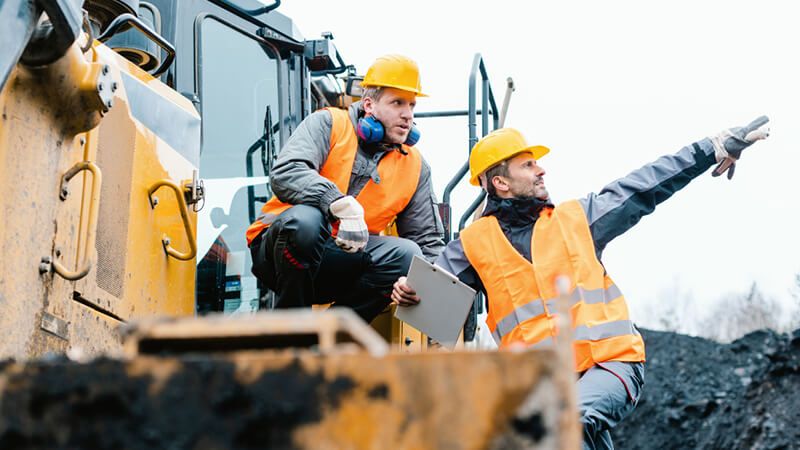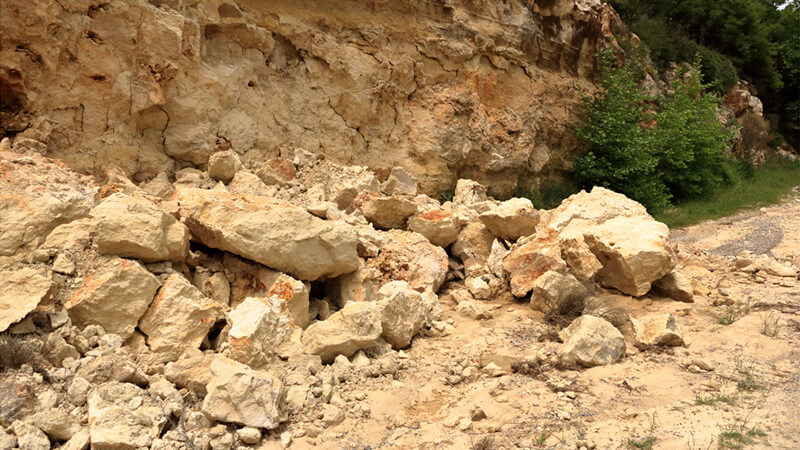How to Mitigate the Risk of Rock Excavation

Rock excavation comes with serious risks that require targeted safety measures. Falling rocks and hazardous atmospheres are prime examples of why mastering how to mitigate the risk of rock excavation is crucial.
The unpredictable nature of rock, paired with heavy equipment, calls for rigorous safety protocols and protective systems to keep your crew safe and your project on course.
This blog covers key OSHA standards, highlights common excavation hazards, and offers practical strategies to keep your site secure. Proper risk management is crucial, especially when facing challenges like toxic gases or unstable trench edges.
For tough rock, rock grinders and rock crushers from RockZone Americas deliver the precision and power needed to handle the job safely and efficiently. Ready to mitigate those risks? Let’s get started.
Key Takeaways
- Effective risk management in rock excavation requires the right tools, thorough planning, and proactive safety measures.
- Protecting your crew from excavation hazards starts with understanding the risks and using advanced protective systems.
- RockZone Americas offers the expertise and equipment you need to tackle rock excavation challenges safely and efficiently.
What Is Rock Excavation?
Rock excavation is the process of removing rock to create a man-made cut in the Earth’s surface. This type of excavation is more complex than others, such as narrow excavation or trenching, due to the unique excavation hazards it presents.
Earth removal in rock excavation requires specialized techniques and protective systems to handle the challenges posed by the material’s hardness and unpredictability.
While stable rock might seem secure, the risks of falling rock, cave-ins, and unexpected ground conditions make excavation safety crucial. Managing these risks requires heavy equipment and a deep understanding of protective systems designed specifically for rock excavation.
6 Hazards in Rock Excavation and How to Handle Them

Rock excavation comes with serious risks that can jeopardize safety and project success. Managing these challenges requires clear strategies and a proactive approach.
Below, we outline the potential hazards and effective methods to manage these risks and keep your excavation projects on track.
1. Falling rocks
Falling rocks are a critical hazard in rock excavation, often caused by unstable formations or vibrations from heavy equipment. These dislodged rocks pose a serious threat to workers, leading to severe injuries or even fatalities.
Attenuator systems and protective barriers must be in place to control the rockfall trajectory and protect workers.
Regular inspections by a competent person are essential to assess rock stability, while strict adherence to OSHA excavation standards is necessary to maintain a safe excavation area. These measures are vital in minimizing the risks and preventing accidents on-site.
2. Cave-ins
Cave-ins present a significant danger in rock excavation, especially around trenches and trench edges. These incidents can happen suddenly, burying workers under collapsed soil or rocks.
To combat this risk, trench boxes, shoring, and correct sloping techniques are essential for stabilizing trench walls. Following soil classification guidelines is crucial to identify the appropriate protective system needed for the excavation site.
Continuous monitoring and regular inspections by a competent person are imperative to ensure trench stability and safeguard workers from potentially fatal cave-ins.
3. Hazardous atmospheres
Hazardous atmospheres, such as toxic gases and low oxygen levels, are serious risks in deep or confined excavations. These conditions can lead to suffocation, poisoning, and other life-threatening injuries for workers.
Thorough air monitoring is needed to detect harmful gases before work begins. Installing ventilation systems helps maintain adequate airflow in the excavation area.
Providing workers with proper PPE is essential to protect them from inhaling toxic substances, keeping them safe in these high-risk environments.
4. Falling loads
Falling loads from heavy equipment or loose materials are a significant hazard on construction sites. These incidents can lead to severe injuries or fatalities if workers are struck.
To prevent such accidents, proper loading and unloading procedures must be strictly followed. Warning signs and barriers should be placed to keep workers at a safe distance from areas where heavy loads are being handled.
Training workers on the correct operation of heavy equipment is also critical to reducing the risk of falling loads and maintaining excavation safety.
5. Underground utilities
Striking hidden utility lines during excavation work can result in severe consequences like electrocution, gas leaks, or explosions. Conducting a thorough site survey is essential.
Advanced technology like ground-penetrating radar accurately detects underground utilities. Strict adherence to OSHA excavation standards is required for safe digging near these lines.
Marking the utilities and avoiding mechanical digging in their vicinity are crucial steps to protect workers and employees, prevent accidents, and safeguard the surrounding community.
6. Contaminated soil
Excavating contaminated soil poses significant health risks and environmental hazards, particularly when the soil is tainted with hazardous materials like chemicals or heavy metals.
Testing the soil for contaminants before excavation work begins is essential. Once identified, proper containment and disposal methods are required to safely handle these dangerous materials.
Equipping workers with appropriate PPE and providing thorough training in handling contaminated soil are critical steps to minimize exposure and ensure excavation safety.
How RockZone Americas Can Help
RockZone Americas understands the unique challenges of rock excavation, and we're here to help you overcome them with specialized equipment designed for safety and efficiency.
Our advanced tools, including RockWheels, RockCrushers, and RockSplitters, are built to handle even the toughest stable rock conditions while keeping your crew safe. We ensure that our equipment meets strict OSHA standards and supports essential protective systems to minimize risks like falling rocks and cave-ins.
When you partner with us, you’re getting top-tier equipment and also gaining our expertise. We work closely with you to select the right tools for your project, ensuring that your excavation practices are efficient and compliant with occupational safety regulations.
If you’re ready to take your project to the next level with equipment you can trust, call us today.
Summary
Falling rocks, cave-ins, and toxic gases pose significant risks during rock excavations. Each hazard demands focused management using the right protective system. Regular checks by a competent person and strict adherence to OSHA excavation standards are a must.
Addressing these risks head-on keeps your workers and other employees safe and your excavation projects on track.
Effective risk mitigation is about following regulations, actively protecting your team, and securing your construction sites. RockZone Americas stands ready to support you with specialized equipment and expert guidance.
Frequently Asked Questions
What are the mitigation measures for excavation?
Mitigation measures for excavation safety include using protective systems such as trench boxes, shoring, and attenuator systems to prevent cave-ins and falling rocks.
Regular inspections by a competent person are crucial to assess trench stability, while strict adherence to OSHA excavation standards helps control hazards and protect workers.
What are the safety precautions for excavation?
Safety precautions for excavation include ensuring all trenches are covered or protected with shoring to prevent cave-ins, using warning signs around the excavation site, and maintaining safe slope and width ratios.
Employers must also provide proper training and PPE to protect workers from exposure to hazardous conditions.
How can you protect yourself when excavating?
To protect yourself during excavation, always follow OSHA regulations, use the appropriate PPE, and avoid entering an unprotected trench.
Stay alert to your surroundings, especially the stability of the ground, and report any concerns to a competent person immediately to maintain excavation safety.
What is the most common hazard during an excavation?
The most common hazard during excavation is a cave-in. This occurs when the sides of an unprotected trench collapse, burying workers under soil or concrete.
Preventing cave-ins requires the use of shoring, trench boxes, and proper slope management to control and stabilize the excavation site.
What is the risk assessment for excavation?
Risk assessment for excavations involves evaluating the depth, slope, and stability of the earth's surface formed during trenching.
A registered professional engineer may use tabulated data to determine the necessary protective systems and methods to control hazards and ensure worker safety.
What is used to stabilize the sides of an excavation?
Shoring systems, such as aluminum hydraulic supports, are commonly used to stabilize the sides of an excavation. These protective systems help to control the slope and width of trenches, preventing cave-ins and keeping the site safe.
What is the best safety practice in or around an excavation?
When working in or around an excavation, ensure that all trenches are properly covered or supported by a protective system like shoring or aluminum hydraulic supports.
Workers should also maintain a safe slope and width for the trench and follow guidelines set by the health administration to prevent accidents such as cave-ins. Regular inspections and adherence to safety protocols are essential to control risks.
What is the safest way to get into and out of a deep excavation?
The safest way to enter and exit a deep excavation is by using a secured and properly designed access point, like a ladder, ramp, or stairway. These access routes should be sturdy, well-maintained, and designed to accommodate the depth and slope of the excavation.
Ensuring these pathways are stable and compliant with safety standards helps protect workers from falls and other risks, making it easier to move safely in and out of the work area.
